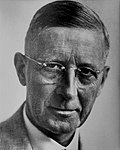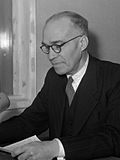| Schermerhorn–Drees cabinet | |
|---|---|
Cabinet of the Netherlands | |
  Presentation of the incoming cabinet at the Binnenhof on 4 June 1946 Presentation of the incoming cabinet at the Binnenhof on 4 June 1946 | |
| Date formed | 25 June 1945 (1945-06-25) |
| Date dissolved | 3 July 1946 (1946-07-03) 1 year, 8 days in office (Demissionary from 16 May 1946 (1946-05-16)) |
| People and organisations | |
| Monarch | Queen Wilhelmina |
| Prime Minister | Willem Schermerhorn |
| Deputy Prime Minister | Willem Drees |
| No. of ministers | 16 |
| Member party | 25 June 1945 – 9 February 1946 Roman Catholic State Party (RKSP) Social Democratic Workers' Party (SDAP) Free-thinking Democratic League (VDB) 9 February 1946 – 3 July 1946 Anti-Revolutionary Party (ARP) Christian Historical Union (CHU) (Confidence and supply) |
| Status in legislature | Centre-left Majority government (Grand coalition/Provisional) |
| History | |
| Legislature terms | 1937–1946 |
| Incoming formation | 1945 formation |
| Outgoing formation | 1946 formation |
| Predecessor | Third Gerbrandy cabinet |
| Successor | First Beel cabinet |
| Part of the Politics series |
| Politics of the Netherlands |
|---|
 |
| Constitution |
| Monarchy |
| Cabinet |
| States General |
| Judiciary |
| Elections |
| Local government |
| Foreign relations |
| Related topics |
|
|
The Schermerhorn–Drees cabinet was the executive branch of the Dutch Government from 25 June 1945 until 3 July 1946. The cabinet was formed by the christian-democratic Roman Catholic State Party (RKSP), the social-democratic Social Democratic Workers' Party (SDAP) and the social-liberal Free-thinking Democratic League (VDB) by royal decree following the end of World War II. The cabinet was a provisional centre-left grand coalition and had a substantial majority in the House of Representatives, with prominent civil engineer Willem Schermerhorn of the Free-thinking Democratic League serving as Prime Minister. Social Democratic Leader Willem Drees served as Deputy Prime Minister and Minister of Social Affairs.
This, the first Dutch cabinet after World War II, was appointed by Queen Wilhelmina just a month after the Netherlands were liberated by the Allied forces. It was a royal cabinet (which means that the cabinet is appointed by the monarch, and is not the result of an election). The States-General of the Netherlands was not yet functional, and would not become so until November 1945.
The cabinet served during the early days of the post-World War II 1940s. Domestically, it initiated recovery and rebuilding, and implemented several major reforms to social security. Internationally, the formation of the United Nations was started and the beginning of the decolonization of the Dutch East Indies.
The Schermerhorn–Drees cabinet consisted of ministers from the SDAP (which in 1946 merged with the VDB and the CDU to become the post-War PvdA or Labour Party), the CHU minister Dr. Piet Lieftinck (who became a member of the PvdA on 9 February 1946), the ARP and the RKSP (named the KVP on 22 December 1945). Prime Minister Willem Schermerhorn was a member of the VDB, but would later become a member of the PvdA. Deputy Prime Minister Willem Drees was a member of the SDAP.
Cabinet actions
One of the main tasks of the cabinet was to revive the Dutch economy after the war and to rebuild the devastated infrastructure (ports, railroads, roads). Furthermore the Dutch administration had to be restored. Furthermore the cabinet had to deal with the arrest and prosecution of Dutch war criminals and Dutch collaborators.
Until August 1945 the war against Japan in the Dutch East Indies was also a main objective of the cabinet. After the Japanese surrender the cabinet was faced with the Indonesian nationalists Sukarno and Hatta, who proclaimed the independence of their country.
Another objective of the cabinet was the purification of the black money circuit. During the period the bank accounts in the Netherlands were under investigation by the Ministry of Finance, every Dutch citizen was given 10 guilders by the cabinet, in the Netherlands known as 'Het tientje van Lieftinck' (Lieftinck's tenner), named after the minister of Finance, Dr. Lieftinck.
Cabinet members
Trivia
- Four cabinet members had previous experience as scholars or professors: Willem Schermerhorn (Hydraulic Engineering and Surveying), Louis Beel (Administrative Law), Piet Lieftinck (Financial and Business Economics), Gerard van der Leeuw (History of Religion and Egyptian Language and Hieroglyphs).
References
- Changing Liaisons The Dynamics of Social Partnership in 20th Century West-European DemocraciesBy Karel Davids, 2007, P.165
- Changing Liaisons The Dynamics of Social Partnership in 20th Century West-European DemocraciesBy Karel Davids, 2007, P.165
- "Coalities tussen sociaaldemocraten en confessionelen" (in Dutch). Historisch Nieuwsblad. 10 August 2006. Retrieved 24 April 2018.
- F.J.F.M. Duynstee; J. Bosmans (1977). Parlementaire geschiedenis van Nederland na 1945, deel 1, Het kabinet-Schermerhorn-Drees (1945-1946). Van Gorcum. p. 5. ISBN 90-232-1412-9.
External links
- Official
- (in Dutch) Kabinet-Schermerhorn/Drees Parlement & Politiek
- (in Dutch) Kabinet-Schermerhorn-Drees Rijksoverheid














